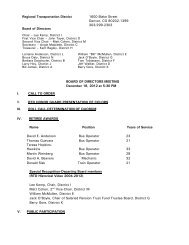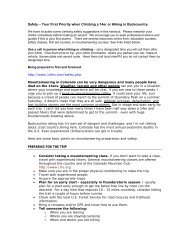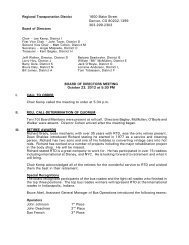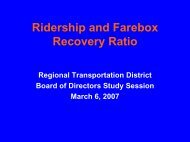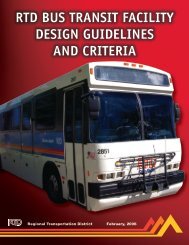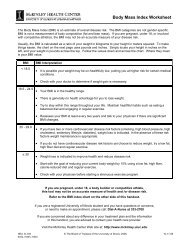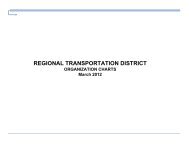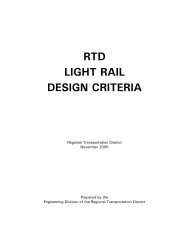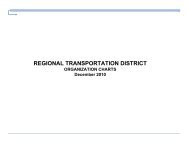Commuter Rail AC Electrification Load-Flow Simulation Report - RTD
Commuter Rail AC Electrification Load-Flow Simulation Report - RTD
Commuter Rail AC Electrification Load-Flow Simulation Report - RTD
Create successful ePaper yourself
Turn your PDF publications into a flip-book with our unique Google optimized e-Paper software.
<strong>Commuter</strong> <strong>Rail</strong> <strong>AC</strong> <strong>Electrification</strong> <strong>Load</strong>-<strong>Flow</strong> <strong>Simulation</strong> <strong>Report</strong> Revision 1<br />
The RR software uses a dynamic performance algorithm for adjusting the trains’ performance<br />
based on the instantaneous system electrical loading where most other simulators assume a<br />
fixed performance value irrelevant of actual train voltage. RR uses "snapshots" at one second<br />
intervals to increment the calculations of vehicle performance and the system electrical load.<br />
RR uses the train’s actual voltage and its corresponding current to determine the load on the<br />
traction power system. As these values change, the available tractive effort is re-calculated and<br />
applied to the performance of the train to determine the trains’ current requirements. This is<br />
performed individually for each train on the system at each snapshot. The calculations are<br />
modified each time there is a change to the system, and consequently, train locations vary<br />
slightly from run to run due to actual performance associated with each train’s actual train<br />
voltage. Therefore, each train on the system affects all other trains on the system and visa<br />
versa.<br />
Each train’s performance is individually calculated based on local conditions and the<br />
subsequent location of each train updated. The electrical system is then re-evaluated through a<br />
matrix calculation. The result is a more accurate representation of system performance under<br />
actual conditions as individual train performance is dependent on both the traction power<br />
system and other trains on the system. Train performance may appear to vary run to run, but<br />
this is actually representative of total system dynamics that will be seen in service.<br />
The simulation output is dependent on operating assumptions such as system population which<br />
is determined by headway, train consist, and train departure scheduling. The results presented<br />
in this report represent only one possible combination of such operating assumptions. Variable<br />
operator behavior, dwell times, passenger loads, and weather or track conditions, along with<br />
potential train bunching and special events trains will change actual system performance.<br />
Design standards were developed for minimum train voltage to try to allow for real-world<br />
performance and operation anomalies since there is no practical way to simulate every possible<br />
scenario or situation.<br />
4.2 STUDY PROCEDURE<br />
The computer load-flow study simulations were performed in the following steps:<br />
• Development of study criteria<br />
• Collection of route alignment data, operation data, and train data<br />
• Conversion of collected data into computer input data<br />
• Trip duration computer runs and development of string charts<br />
• Analysis of trip duration and string chart results<br />
• Collection of electrical network parameters and system operations data<br />
• Conversion of collected data into computer input data<br />
• Electrical system computer runs, including:<br />
o All equipment in-service scenarios<br />
o Contingency conditions such as substations out-of-service<br />
02/27/2009 FRSC Page 14 of 250




